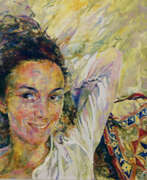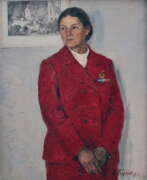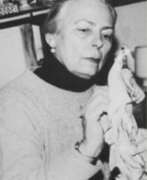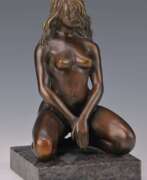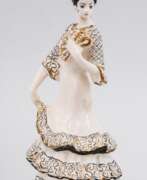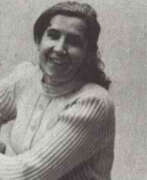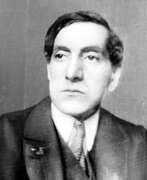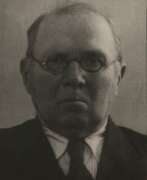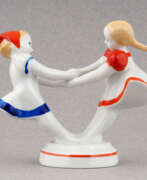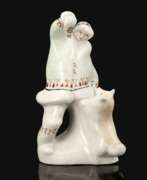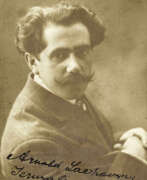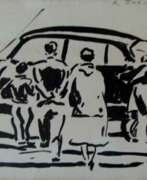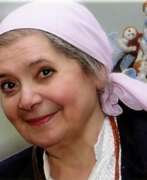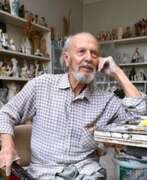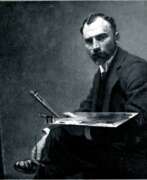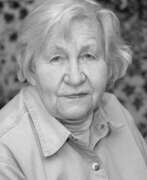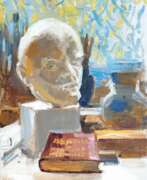Genre painters Ukraine
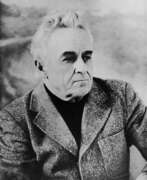

Alexander Grigorievich Maksymenko (Russian: Александр Григорьевич Максименко) was a Soviet and Ukrainian painter of the second half of the twentieth and early twenty-first centuries. He is known as a painter, graphic artist, watercolorist, and art historian.
Alexander Maksymenko worked in the genres of still life, landscape, portrait, as well as in genre painting. His genre works cover themes of collective farm life, including "Masters of the Land" and "Innovators of Collective Farm Fields". For the latter work he received the Stalin Prize. The master actively participated in exhibitions in Ukraine and abroad. His works are in the National Art Museum of Ukraine, the Museum of the History of Ukraine in World War II, as well as in other art museums and private collections.
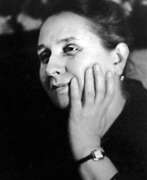

Taisia Kirillovna Afonina (Russian: Таисия Кирилловна Афонина) was a Soviet artist of the second half of the twentieth century. She is known as a painter, graphic artist, representative of the Leningrad school.
Taisia Afonina participated in exhibitions since 1940, creating portraits, landscapes, genre compositions, still lifes and etudes. At the beginning of her career she was interested in military subjects, and then delved into the genre of portraiture and lyrical landscape. Her style is characterized by tonal painting, the rendering of light and air environments and subtle coloristic combinations. In the 1980s she preferred the watercolor technique, painting flowers such as roses, daisies and tulips. Her works are in museums and private collections in Russia and other countries.
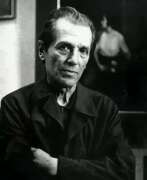

Piotr Petrovich Belousov (Russian: Пётр Петро́вич Белоу́сов) was a distinguished Soviet and Russian artist, born on May 3, 1912, in Berdyansk, and passed away on March 31, 1989, in Leningrad. He is widely celebrated for his contributions to the Leningrad School of Painting, having been an influential figure in shaping the artistic landscape of the region. His expertise extended across various mediums, including painting, etching, and graphic arts, with a notable focus on themes like the Bolshevik Revolution and historical Soviet figures like Lenin.
Belousov's educational and professional journey was deeply intertwined with the prestigious Ilya Repin Leningrad Institute of Painting, Sculpture and Architecture, where he both studied and later taught, eventually rising to the rank of professor and head of the drawing department by 1956. His career was marked by numerous accolades, including the titles of Honored Artist and People's Artist of the RSFSR, reflecting his significant impact on Russian art and education.
Throughout his life, Belousov participated in many exhibitions and his works are held in high esteem, not only in Russian state museums like the Russian Museum and the Tretyakov Gallery but also internationally. His pieces, particularly those that capture key moments in Soviet history and urban landscapes, remain influential and are sought after by collectors around the worl.
For enthusiasts of Soviet art and collectors interested in Belousov's works, staying updated on exhibitions and sales can provide valuable opportunities to acquire his art. To receive alerts about new product sales and auction events featuring Piotr Petrovich Belousov's works, signing up for updates is highly recommended.
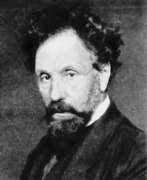

Nikolai Kornilievich Bodarevsky (Russian: Николай Корнилиевич Бодаревский) was a Russian and Ukrainian artist of the last third of the 19th and early 20th centuries of Moldavian origin. He is known as a painter and graphic artist.
Nikolai Bodarevsky created portraits, landscapes and genre paintings. During the early period of his creativity, he was close to the Itinerants, in later years he departed from the Itinerant traditions in the direction of the late "salon" academism. His works are in many museum collections, including the State Tretyakov Gallery in Moscow and the State Russian Museum in St. Petersburg.
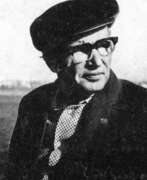

Nikolay Stepanovich Borovsky (Russian: Николай Степанович Боровский) was a Soviet Ukrainian artist of the second half of the twentieth century. He is known as a painter and teacher.
Nikolay Borovsky became famous for his portraits, landscapes and still lifes, as well as genre paintings. Some of his works were characterized by extraordinary realism. Since the early 1960s, he actively exhibited his works and in 1964 joined the Union of Artists of the USSR. For his painting "Worker. Year 1928" he received the prize of the Union of Artists of the Ukrainian SSR.
The master created a significant number of works that are in private and public collections, including a gallery of portraits of participants in the defense and liberation of Dnepropetrovsk.
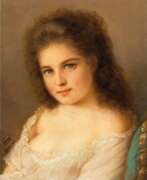

Mikhail Vasilyevich Bryansky (Russian: Михаил Васильевич Брянский) was a Russian artist of the second half of the nineteenth and early twentieth centuries. He is known as a painter and graphic artist.
Mikhail Bryansky lived in Kiev and St. Petersburg. He painted mainly "female heads", portraits and genre paintings, marked by features of academism. His works were published in a number of art and illustrated magazines.


Joseph-Casimir Konstantinovich Budkevich (Russian: Иосиф-Казимир Константинович Будкевич) was a Ukrainian painter and draftsman, born on April 18, 1841, in Kyiv. Known for his battle scenes and landscapes, Budkevich studied at the Imperial Academy of Arts in Saint Petersburg, where he received several medals for his works. In 1873, he was awarded the title of Class Artist 3rd Degree.
Budkevich traveled to Italy, France, Spain, and Palestine to refine his skills. In the late 1870s and 1880s, he taught at the Kyiv Drawing School, where one of his students was Mykola Pymonenko. From 1887 to 1895, he was a member of the Kyiv Society of Art Exhibitions.
Among his notable works are "Pilgrim at the Monastery Wall" (1883) and "Jerusalem" (1894). These paintings are exhibited at the Kyiv Museum of Russian Art and the Pskov Art Gallery. His work is highly valued by collectors and art experts for its uniqueness and mastery.
If you want to receive notifications about new arrivals and auctions related to Joseph-Casimir Budkevich's work, subscribe to our updates. We will keep you informed about new sales and events related to his legacy.


Leonid Ivanovich Chernov (Russian: Леонид Иванович Чернов) was a Soviet Ukrainian artist of the second half of the twentieth century. He is known as a painter, graphic artist and teacher.
Leonid Chernov created in various genres, including landscape, still life and genre painting. He has participated in numerous exhibitions since 1945. His work was inspired by business trips to India, Afghanistan, Bulgaria and Cuba. Notable works include cycles of landscapes "Across Ukraine", etchings "In Folk Bulgaria", drawings dedicated to Ukrainian folk songs and poems by Soviet poets.
Chernov nurtured a galaxy of Ukrainian artists and played an important role in the development of the Ukrainian art community.
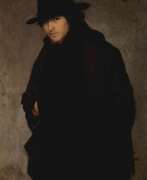

Philipp Antonovich Chirko (Russian: Филипп Антонович Чирко) was a Russian and Ukrainian painter, born on July 3, 1859, in Kyiv. Chirko was known for his realistic style and was associated with the Peredvizhniki movement, a group of artists committed to social realism and traveling exhibitions. He studied at the Kyiv Drawing School and later at the Imperial Academy of Arts in Saint Petersburg, graduating in 1892.
Chirko’s works often depicted battle scenes, genre paintings, and landscapes of Ukraine. Notable paintings include "The Pursuit of French Mounted Chasseurs by the Horse Guards under Polotsk on August 6, 1812," which is part of the Borodino Panorama Museum's collection in Moscow. Unfortunately, many of his works were lost during World War II.
Chirko’s remaining works are highly valued by collectors and can be found in various Russian museums, including the Chernihiv Art Museum. His contribution to art is significant for its historical and artistic value, capturing the essence of his era.
Sign up for updates related to Philipp Antonovich Chirko to receive notifications about new product sales and auction events.
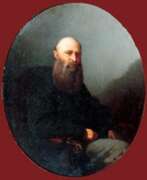

Romuald Chojnacki was a mid-nineteenth-century Russian artist of Polish descent. He is known as a painter and teacher.
Romuald Chojnacki was a follower of the Italian school of painting. He worked mainly in portrait and religious genres. At the beginning of his career, he also created historical paintings and returned to this genre shortly before his death.
The master was one of the founders of the Odessa Drawing School. Among his pupils was the famous Polish artist Stanisław Chlebowski.
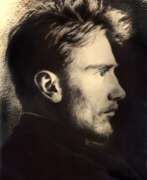

Grigory Kononovich Dyadchenko (Russian: Григорий Кононович Дядченко) was a Ukrainian artist and educator, born on October 8, 1869, in Kirilovka. Known for his landscape and portrait paintings, Dyadchenko's work embodies the realism movement. He studied at the Kyiv Drawing School and later graduated from the Imperial Academy of Arts in St. Petersburg, where he earned multiple awards.
Dyadchenko's artistry is evident in his poetic landscapes such as "Evening on the Dnieper" and "Kiev. View of Podil," which are characterized by their atmospheric depth and emotional resonance. His portraits, including "Head of a Girl" and the depiction of sculptor F. Balavensky, are celebrated for their psychological insight.
Dyadchenko also contributed to art education by teaching at the Kyiv Drawing School, influencing future artists like Mykhailo Kozyk and Vasyl Sylvestrov. His works are preserved in the National Art Museum of Ukraine and other prominent collections.
For those interested in Dyadchenko's art, sign up for updates on new product sales and auction events related to his masterpieces.
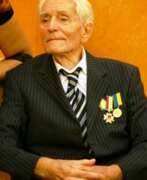

Albin Stanislavovich Gavdzinsky (Russian: Альбин Станиславович Гавдзинский) was a Soviet and Ukrainian artist of the second half of the twentieth and early twenty-first centuries. He is known as a painter, famous for his landscapes, genre paintings and portraits.
Albin Gavdzinsky in the early 1950s held his first solo exhibitions in Odessa, Kiev and Kharkov and showed his bright artistic personality. The artist was distinguished by his outstanding efficiency and precision in depiction, which was evident in his clear forms and bright colors. In 1961 he was recognized as Honorary Citizen of the city of Novaya Kakhovka, and his works (237 canvases) served as the basis for the creation of the city's art gallery, which in 2003 was named after him.
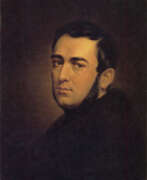

Jan Ksawery Kaniewski (Russian: Ян Ксаверий Каневский) was a Polish and Russian artist of the mid-19th century. He is known as a portrait painter.
Jan Kaniewski painted numerous portraits of members of the Russian imperial family (including Nicholas I) and the high society of the Kingdom of Poland. He also created a number of paintings on historical and religious themes.
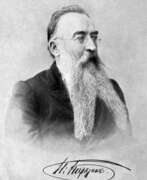

Nikolay Nikolaevich Karazin (Russian: Николай Николаевич Каразин) was a Russian military officer, painter, and writer, known for his depictions of wars and exotic places. Born in 1842 in Kharkov (now Ukraine), Karazin came from a family of prominent intellectuals, including his grandfather Vasily Karazin, who founded Kharkiv University.
Karazin's career began in the military, where he participated in campaigns against the January Uprising in Poland and in Central Asia. His firsthand experiences in battles, such as the 1868 Bukhara campaign and the 1873 Khiva campaign, greatly influenced his later work as a painter and writer. After retiring from the military, he focused on creating large canvases depicting military actions in Turkestan, as well as writing numerous adventure and ethnographic stories and novels.
Karazin's works, which include "In the Distant Confines" (1875) and "From Orenburg to Tashkent" (1886), reflect his deep engagement with the landscapes and cultures of Central Asia. His children's book "Cranes Flying South" remains popular for its vivid storytelling and illustrations. Karazin also contributed significantly to the visual arts, participating in early designs for the Moscow Metro and becoming an academician of the Imperial Academy of Arts in 1904.
To stay updated on new product sales and auction events related to Nikolay Karazin's works, sign up for our updates. This subscription will keep you informed about the latest opportunities to acquire pieces of his illustrious legacy.
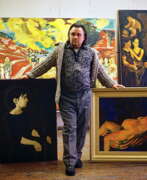

Alexander Mikhailovich Kishchenko (Russian: Александр Михайлович Кищенко) was a Soviet and Belarusian artist of the second half of the twentieth century. He is best known as a muralist painter.
Alexander Kishchenko is considered one of the most famous artists of Belarus of the 20th century, and his works are valuable assets of Belarusian culture. He worked in all genres of easel and monumental decorative painting and created hundreds of works during his career, including philosophical paintings and portraits. The artist was also proficient in mosaics, ceramics and tapestry.
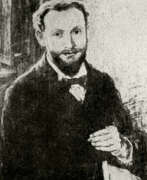

Solomon Yakovlevich Kishinevsky (Russian: Соломон Яковлевич Кишинёвский) was a Russian and Soviet artist of the late 19th and the first half of the 20th centuries of Jewish origin. He is known as a painter, graphic artist and teacher, a prominent representative of the Southern Russian school of painting.
Solomon Kishinevsky worked in domestic, portrait and landscape genres. At the beginning of his career, he was fond of German and Italian classicism, then French impressionism, but the first serious works he created under the strong influence of the Itinerants. His life sketches, scenes from the life of the urban poor were acutely social, the artist has a special attention to the everyday existence of the "little man.
Kishinevsky died presumably in 1941 during the Nazi occupation of Odessa.
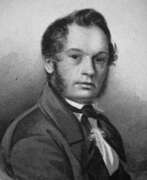

Evgraf Fedorovich Krendovsky (Russian: Евграф Фёдорович Крендовский) was a Russian artist born in 1810 in Kremenchuk, now part of Ukraine, renowned for his work in portrait, genre, and interior painting. Initially engaged in police work in Arzamas, Krendovsky shifted his focus to art, studying under the guidance of Alexey Venetsianov in St. Petersburg from 1830 to 1835. Despite a promising start, family circumstances forced him to return to Kremenchuk, where he became a drawing tutor and later achieved the status of "Free Artist" by the Imperial Academy of Arts.
Krendovsky's career is marked by a relatively small body of work, with just over twenty known paintings to his name. Some of his most celebrated pieces include portraits and scenes depicting the daily life of Russian society, which now grace collections such as the Tretyakov Gallery in Moscow and the Russian Museum in St. Petersburg. His notable works include "Portrait of an Unknown Woman in a Violet Dress" and "The Artist’s Daughters" from 1845.
For art enthusiasts and collectors interested in 19th-century Russian art, Krendovsky remains a figure of fascination due to his unique style and the historical context of his works. To stay updated on upcoming sales and auction events featuring Krendovsky's works, sign up for updates at [Link to subscription page]. This subscription will keep you informed about new opportunities to acquire pieces by this distinctive artist.
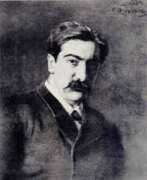

Nikolai Dmitriyevich Kuznetsov (Russian: Николай Дмитриевич Кузнецов) was a Ukrainian artist, celebrated for his profound skill in portraiture and genre scenes. Born on December 2, 1850, in the Kherson Governorate of the Russian Empire, he rose to prominence as an art professor at the St. Petersburg Imperial Academy of Arts. His works, notably his portraits, are known for their depth and psychological insight, capturing the essence of his subjects with remarkable clarity.
Kuznetsov's portfolio includes influential Russian figures such as the composer Pyotr Ilyich Tchaikovsky, whose portrait by Kuznetsov is praised for capturing the composer's introspective tragedy. This piece remains a highlight at the Tretyakov Gallery, illustrating Kuznetsov’s ability to translate the inner life of his subjects onto canvas.
Throughout his career, Kuznetsov was involved with the Peredvizhniki, a group of artists who eschewed the formal constraints of academic art to focus on realistic portrayals of everyday life. He became an academician in 1900 and continued to influence the Russian art scene until his emigration to Yugoslavia following the upheaval of the Russian Civil War. He passed away on March 2, 1929, in Sarajevo.
For those interested in exploring Nikolai Dmitriyevich Kuznetsov’s life and works further, updates and details about upcoming sales and exhibitions can be found by subscribing here. Stay informed about the availability of his renowned artworks and ensure you don't miss out on acquiring a piece of art history.
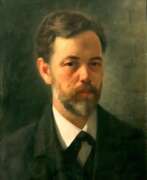

Andronik Grigorievich Lazarchuk (Russian: Андроник Григорьевич Лазарчук) was a Ukrainian and Soviet artist, born on January 15, 1870, in Ukhovetsk, Volhynian Governorate, and passed away on September 6, 1934, in Borzna, Chernihiv region. Known for his contributions to painting, teaching, and cultural activities, Lazarchuk's work primarily featured portraits, everyday scenes, and landscapes.
Lazarchuk began his artistic journey studying icon painting in Kovel and later in the Pochaev Lavra's painting workshop. From 1889 to 1897, he attended the Higher Art School at the Imperial Academy of Arts in St. Petersburg, where he studied under prominent artist Vladimir Makovsky. His artistic style was influenced by his early religious training, which is evident in his detailed and expressive portraits and landscapes.
One of his notable works, "Portrait of a Man," showcases his ability to capture human emotion and character. His other works include small-format paintings like "Reading a Letter" and "Family Group," which highlight his focus on everyday life and personal interactions. Lazarchuk also contributed to the decoration of Ukrainian churches, such as the Holy Trinity Church and the Cave Churches of Pochaev Lavra, and worked as an illustrator for magazines like "Native Land" and "Young Ukraine".
Collectors and art enthusiasts can explore Lazarchuk's legacy by signing up for updates on new product sales and auction events related to his works. This subscription will keep you informed about opportunities to acquire pieces by this influential artist.
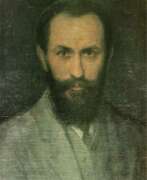

Anton Ivanovich Manastyrsky (Russian: Антон Иванович Манастырский) was a Ukrainian and Soviet artist of the twentieth century. He is known as a painter and graphic artist.
Anton Manastyrsky became famous for his genre paintings based on Ukrainian folk songs. His works are characterized by plasticity, rhythm and poetry. He also worked in the portrait genre, creating such canvases as "Portrait of Mother", "Portrait of Taras Shevchenko" and others. The master also illustrated books and worked in the religious genre, restoring the iconostasis in the Church of the Assumption of the Blessed Virgin Mary in Ancient Galich.


Vitold Antonovich Manastyrsky (Russian: Витольд Антонович Манастырский) was a Ukrainian and Soviet artist of the second half of the twentieth century. He is known as a painter, graphic artist, teacher, and son of the artist Anton Manastyrsky.
Vitold Manastyrsky created many works, including genre paintings, portraits, landscapes and still lifes. In his works he reflected the beauty of the Pre-Carpathian region, the life of its inhabitants, as well as portrayed his contemporaries - workers, peasants and cultural figures. He was active both creatively and in public and pedagogical spheres, he was often elected to the governing bodies of the Union of Artists of Ukraine. Many of his works are exhibited in Ukrainian museums and galleries.
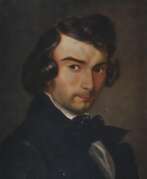

Apollon Nikolaevich Mokritsky (Russian: Аполлон Николаевич Мокрицкий) was a Ukrainian-Russian painter and art educator, known for his contributions to the 19th-century art scene. Born in 1810 in Pyryatyn, Ukraine, Mokritsky became an influential figure in Russian academic art, specializing in portrait and historical painting.
Mokritsky's work is celebrated for its detailed realism and emotional depth. His portraits often capture the essence of his subjects, showcasing his skill in rendering lifelike expressions and intricate details. One of his most notable works is the portrait of the renowned Russian poet, Taras Shevchenko, which exemplifies his ability to combine technical precision with profound sensitivity.
In addition to his painting, Mokritsky played a significant role as an educator. He taught at the Moscow School of Painting, Sculpture and Architecture, where he mentored many young artists who would go on to shape Russian art. His influence extended beyond his own works, helping to cultivate a new generation of artists.
Today, Mokritsky's paintings can be found in various museums and galleries, including the Tretyakov Gallery in Moscow. His contributions to art and education continue to be recognized and celebrated by art collectors and historians alike.
Sign up for updates to learn more about new product sales and auction events related to Apollon Nikolaevich Mokritsky.
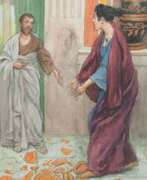

Felician Myrbach, an Austrian artist renowned for his multifaceted contributions to the art world, was a significant figure in the late 19th and early 20th centuries. Born in Zalesciki, Ukraine, in 1853, Myrbach's career spanned various roles, including painter, illustrator, and graphic artist. His educational journey included teaching at the cadet school in Vienna and studying at the Vienna Academy. In 1881, he moved to Paris to further his career as an illustrator, eventually becoming a professor of Illustration at the Vienna School of Arts and Crafts from 1899 to 1905.
Felician Myrbach's artistry was not confined to one location; he lived and worked in multiple European cities, including Paris, Barcelona, and near Bilbao, before passing away in Klagenfurt, Austria, in 1940. His works were displayed in prestigious exhibitions, such as the Vienna Secession shows and the Royal Watercolour Society in Belgium, showcasing his versatility and the broad appeal of his art.
Felician Myrbach's contributions to book illustration were notable, with his work appearing in various publications, such as Alphonse Daudet’s "Wives of Men of Genius" and "Trente ans de Paris à travers ma vie et mes livres." His distinctive signature can be found on many illustrations, underscoring his significant role in the art of book illustration during his time.
For collectors and experts in art and antiques, Felician Myrbach's works offer a glimpse into the vibrant art scene of his era, reflecting the cultural and artistic movements of the time. His legacy continues to be celebrated and studied, making him a pivotal figure in the history of European art.
For those interested in staying updated on Felician Myrbach, subscribing to updates can be a valuable way to stay informed about new product sales and auction events related to his work. This subscription service is dedicated to providing focused updates, ensuring that enthusiasts and collectors are well-informed about opportunities related to Myrbach's enduring legacy.
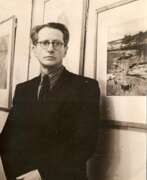

Samuil Grigorievich Nevelshtein (Russian: Самуил Григорьевич Невельштейн) was a distinguished Soviet Russian painter, watercolorist, graphic artist, and art teacher, known for his impactful role in the Leningrad school of painting. Born on March 22, 1903, in Kherson, Ukraine, then part of the Russian Empire, Nevelshtein made a significant mark in the art world with his expressive portraits and scenes reflecting Soviet life.
Nevelshtein's journey in the arts began at VKhuTeMas, a renowned Moscow art school, where he honed his skills before moving to Leningrad. There, he graduated from the Proletarian Institute of Fine Arts and became a pivotal member of the Leningrad Union of Artists from 1935. His artwork primarily includes portraits, genre compositions, and landscapes, showcasing his mastery in both watercolors and oil painting.
His works are held in high esteem and are part of collections in major museums and private collections across the globe, including the State Russian Museum. Nevelshtein's exhibitions were well-received, contributing significantly to the cultural tapestry of Leningrad, now Saint Petersburg, until his death on November 16, 1983.
For those interested in exploring the works of Samuil Nevelshtein or learning about upcoming auctions and exhibitions featuring his art, consider subscribing for updates. This will ensure you are informed about new sales and auction events related to Nevelshtein's works, enhancing your collection and knowledge of this influential artist.
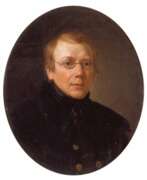

Kapiton Stepanovich Pavlov (Russian: Капитон Степанович Павлов) was a Russian and Ukrainian artist of the first half of the 19th century. He is known as a painter, landscape painter, portraitist, author of genre compositions and teacher.
Kapiton Pavlov was one of the first painters in Ukraine, who depicted in his paintings real scenes from the lives of ordinary people. His portraits are characterized by poetization of the human environment. A special place in his work were children's portraits, which, according to critics, reflected the sentimental and poetic temperament of the Ukrainian soul.
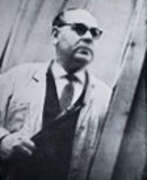

Victor Markiyanovych Savin (Russian: Виктор Маркиянович Савин) was a Ukrainian Soviet artist of the mid-twentieth century. He is known as a painter, graphic artist and teacher.
Victor Savin worked in easel painting, graphics and book illustration. He became famous for his genre paintings of Soviet themes, portraits of prominent personalities, and propaganda posters. An important part of his works are illustrations for Ukrainian fairy tales, novels and stories.
His works are in various museums and galleries in Ukraine and abroad, including the National Museum in Lviv and the Kharkiv Art Museum.


Ivan Fyodorovich Seleznyov (Russian: Иван Федорович Селезнёв) was a Russian and Soviet artist of the last third of the 19th - first third of the 20th centuries. He is known as a painter of academic direction and a teacher.
Ivan Seleznyov worked in historical, portrait and domestic genres, as well as painted landscapes and still lifes. He became famous for his paintings on the subjects of Russian history, life scenes and realistic genre portraits. He also created and restored frescoes in churches in Kiev and was one of the organizers of the Kiev Fellowship of Religious Painting.
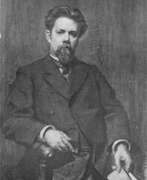

Nikolay Gustavovich Schilder (Russian: Николай Густавович Шильдер) was a Russian painter known for his genre and battle scenes. Born in 1828 in Kharkiv, Schilder became an influential figure in Russian art. He studied at the Imperial Academy of Arts and was influenced by the works of Pavel Fedotov, which led him to focus on genre painting.
Schilder's notable works include "The Temptation" (1857), "Family Happiness" (1858), and "The Repayment of Creditors" (1861), the latter earning him the title of academician. His detailed and emotive portrayal of everyday life and historical events made his works highly regarded in art circles.
Several of his paintings, including portraits of prominent figures such as Alexander III and Maria Feodorovna, are displayed in museums like the State Russian Museum and the Orsay Museum in Paris.
Stay updated on new sales and auction events related to Nikolay Gustavovich Schilder by signing up for our updates.


Ivan Nikolayevich Shulga (Russian: Иван Николаевич Шульга) was a Ukrainian Russian and Soviet artist of the first half of the twentieth century. He is known as a master of painting and drawing and a teacher. His name is included in the "Unified Art Rating of the world's 10,000 best artists" and in the list of the 100 most outstanding artists of Ukraine.
Ivan Shulga worked in different genres: he painted portraits, genre paintings, landscapes (marine, landscape, architectural, industrial), created still life paintings, panels, drawings for art postcards, political posters. His artistic legacy also includes pictures in the genre of nude and historical genre. The artist also illustrated magazines and books, designed theatrical sets.
Shulga worked in watercolor, pencil drawing, gouache, ink and sanguine, pastel, oil and tempera painting.
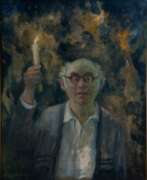

Efim Davidovich Simkin (Russian: Ефим Давидович Симкин) was a Soviet and Russian artist of the second half of the twentieth century. He is known as a portrait painter and genre painter.
Efim Simkin became famous for his psychological portraits, as well as genre paintings. The main place in his work was occupied by the theme of the Second World War, of which he was a participant. Many of his works reflect the horrors of war, death, fear, such as, for example, the paintings "Don Quixote. Horrors of War" and "Holocaust. Victims of War." At the same time, his scenes of peaceful life, according to critics, are full of beauty in the ordinary. Large canvases of the master were characterized by increased drama.
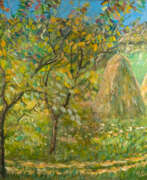

Pyotr Dorofeyevich Slyota (Russian: Пётр Дорофеевич Слёта) was a Ukrainian Soviet artist of the mid-twentieth century. He is known as a painter, famous for his thematic paintings and landscapes.
In his works, according to critics, Pyotr Slyota showed the best features of Soviet art - patriotism, humanism, love for nature. In his work an important place is occupied by works devoted to the history of Ukraine. In landscape works from different countries where the artist visited ("Street in Košice", "Charles Bridge", "Paris. Notre Dame"), he managed to reveal the national and social features of these cities.


Yevgeny Ivanovich Stolitsa (Russian: Евгений Иванович Столица) was a Russian and Soviet artist of the late 19th century and the first third of the 20th century. He is known as a painter and graphic artist.
Yevgeny Stolitsa is best known as a landscape painter. He also painted portraits, historical and battle paintings. His works are distinguished by a fine transmission of the light and air environment, a free impressionistic style of painting, rich and saturated colors with lots of nuances and shades. According to critics, unpretentious rustic motifs in the artist's portrayal acquired a special poeticism.
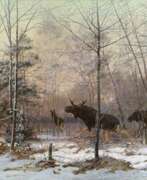

Evgeny Alexandrovich Tikhmenev (Russian: Евгений Александрович Тихменев) was a Russian artist, born in 1869 and passed away in 1934. Renowned for his depictions of natural scenes and hunting expeditions, his works encapsulate the essence of rural Russian life during his time. Tikhmenev's artwork, such as "Before the Hunt," captures moments of anticipation and interaction with nature, often featuring meticulous detail and vibrant settings.
His pieces are cherished in art circles for their historical value and their ability to convey the story of an era when hunting was not only a sport but a significant aspect of rural survival and culture. Notably, Tikhmenev's paintings have been sold at various auctions, with some pieces fetching substantial prices, highlighting their desirability among collectors and art enthusiasts.
For collectors and experts in art and antiques, Tikhmenev's works present a valuable investment, both culturally and financially. To stay updated on new sales and auction events featuring Evgeny Alexandrovich Tikhmenev’s work, signing up for timely updates is recommended, ensuring enthusiasts don't miss out on acquiring a piece of Russian art history.
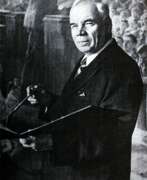

Karp Demyanovich Trokhimenko (Russian: Карп Демьянович Трохименко) was a Soviet Ukrainian painter known for his significant contributions to socialist realism. Born in 1885, Trokhimenko's works primarily depicted scenes of everyday life, socialist construction, and the natural beauty of Ukraine.
Trokhimenko's distinctive style is characterized by his detailed, realistic portrayal of his subjects, capturing the spirit and ideals of the Soviet era. He was celebrated for his ability to convey the human experience within the broader context of socialist society. His paintings often featured vibrant colors and meticulous attention to detail, making them stand out in exhibitions.
Among his notable works are "Shevchenko and Engelhardt" (1939), "Kateryna" (1959), and "May Days in Old Kyiv" (1975), all housed in the National Art Museum of Ukraine. These paintings exemplify his talent in depicting historical and rural life with a sense of warmth and authenticity. Trokhimenko's legacy continues to influence contemporary Ukrainian artists, and his works remain highly regarded in art circles.
For updates on new product sales and auction events related to Karp Demyanovich Trokhimenko, sign up for our newsletter.
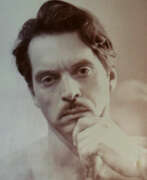

Yuri Vasilievich Volkov (Russian: Юрий Васильевич Волков) was a Soviet artist of the second half of the twentieth century. He is known as a battle painter.
During the Great Patriotic War Yuri Volkov defended Sevastopol, was captured and wounded, liberated the capitals of Europe from the Nazis. In the postwar years he created a series of battle works about the heroism of Soviet soldiers and the tragedy of the German occupation. Volkov's work is also represented by genre paintings about the labor and leisure of Soviet citizens. The artist, being an Orthodox Christian, also painted churches. His works are known for their realism and dynamic composition, which vividly convey the heroism and tragedy of war.


Vasily Alekseyevich Volkov (Russian: Василий Алексеевич Волков) was a Russian and Ukrainian artist of the last third of the 19th - early 20th centuries. He is known as a painter, watercolorist and teacher.
Vasily Volkov painted portraits and paintings on domestic and historical themes. Especially famous are his portraits of Emperors Alexander II and Alexander III, as well as historical portraits.
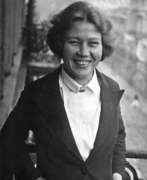

Maria Abramovna Zubreeva (Russian: Мария Абрамовна Зубреева) was a Soviet artist of the twentieth century. She is known as a painter, graphic artist, decorator, representative of the Leningrad school of painting, and one of the first members of the Leningrad Union of Artists. Her work encompassed a variety of genres, including portraits, landscapes, still lifes and genre compositions. She was engaged in both easel and monumental painting, interior decoration, and book illustration. The artist often worked in the technique of watercolor and tempera painting.
Maria Zubreeva, together with her husband, artist Sergey Zakharov, spent many years in Tajikistan, where she made a significant contribution to the art of this region. Her watercolor portraits and eastern landscapes remain the most interesting part of her artistic heritage.
